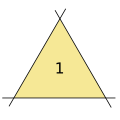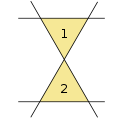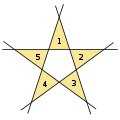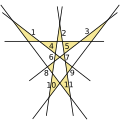Kobon triangle problem
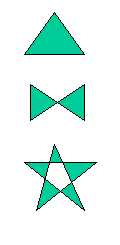
How many non-overlapping triangles can be formed in an arrangement of lines?
The Kobon triangle problem is an unsolved problem in combinatorial geometry first stated by Kobon Fujimura (1903-1983). The problem asks for the largest number N(k) of nonoverlapping triangles whose sides lie on an arrangement of k lines. Variations of the problem consider the projective plane rather than the Euclidean plane, and require that the triangles not be crossed by any other lines of the arrangement.[1]
Known upper bounds[edit]
Saburo Tamura proved that the number of nonoverlapping triangles realizable by lines is at most . G. Clément and J. Bader proved more strongly that this bound cannot be achieved when is congruent to 0 or 2 (mod 6).[2] The maximum number of triangles is therefore at most one less in these cases. The same bounds can be equivalently stated, without use of the floor function, as:
Solutions yielding this number of triangles are known when is 3, 4, 5, 6, 7, 8, 9, 13, 15 or 17.[3] For k = 10, 11 and 12, the best solutions known reach a number of triangles one less than the upper bound.
Known constructions[edit]
The following bounds are known:
| k | 3 | 4 | 5 | 6 | 7 | 8 | 9 | 10 | 11 | 12 | 13 | 14 | 15 | 16 | 17 | 18 | 19 | 20 | 21 | OEIS |
| Tamura's upper bound on N(k) | 1 | 2 | 5 | 8 | 11 | 16 | 21 | 26 | 33 | 40 | 47 | 56 | 65 | 74 | 85 | 96 | 107 | 120 | 133 | A032765 |
| Clément and Bader's upper bound | 1 | 2 | 5 | 7 | 11 | 15 | 21 | 26 | 33 | 39 | 47 | 55 | 65 | 74 | 85 | 95 | 107 | 119 | 133 | - |
| best known solution | 1 | 2 | 5 | 7 | 11 | 15 | 21 | 25 | 32 | 38 | 47 | 53 | 65 | 72 | 85 | 93 | 104 | 115 | 130 | A006066 |
In the projective plane[edit]

The version of the problem in the projective plane allows more triangles. In this version, it is convenient to include the line at infinity as one of the given lines, after which the triangles appear in three forms:
- ordinary triangles among the remaining lines, bounded by three finite line segments,
- triangles bounded by two rays that meet at a common apex and by a segment of the line at infinity, and
- triangles bounded by a finite line segment and by two parallel rays that meet at a vertex on the line at infinity.
For instance, an arrangement of five finite lines forming a pentagram, together with a sixth line at infinity, has ten triangles: five in the pentagram, and five more bounded by pairs of rays.
D. Forge and J. L. Ramirez Alfonsin provided a method for going from an arrangement in the projective plane with lines and triangles (the maximum possible for ), with certain additional properties, to another solution with lines and triangles (again maximum), with the same additional properties. As they observe, it is possible to start this method with the projective arrangement of six lines and ten triangles described above, producing optimal projective arrangements whose numbers of lines are
Thus, in the projective case, there are infinitely many different numbers of lines for which an optimal solution is known.[1]
Examples[edit]
-
3 lines, 1 triangle
-
4 lines, 2 triangles
-
5 lines, 5 triangles
-
6 lines, 7 triangles
-
7 lines, 11 triangles
See also[edit]
- Roberts's triangle theorem, on the minimum number of triangles that lines can form
References[edit]
- ^ a b Forge, D.; Ramírez Alfonsín, J. L. (1998), "Straight line arrangements in the real projective plane", Discrete and Computational Geometry, 20 (2): 155–161, doi:10.1007/PL00009373.
- ^ "G. Clément and J. Bader. Tighter Upper Bound for the Number of Kobon Triangles. Draft Version, 2007" (PDF). Archived from the original (PDF) on 2017-11-11. Retrieved 2008-03-03.
- ^ Ed Pegg Jr. on Math Games
External links[edit]
- Johannes Bader, "Kobon Triangles"








